7COM1012 - Operating Systems and Networks: NFS File System Report
VerifiedAdded on 2022/08/27
|30
|7040
|16
Report
AI Summary
This report provides a detailed analysis of the Network File System (NFS), covering its architecture, history, and evolution. It explores how NFS enables file sharing across networks, discussing its advantages such as machine and operating system independence, crash recovery, and transparent access. The report delves into the NFS protocol, file system interface, and implementation, including various NFS versions and their features. It also examines the experimental evolution of NFS, including creating mount points and tuning the NFS server for performance. Furthermore, the report highlights the advantages and disadvantages of NFS, comparing its performance and functionality with other file-sharing methods. The content covers NFS versions 2, 3, and 4, including the use of UDP and TCP protocols. The report concludes by summarizing the key aspects of NFS and its significance in modern network environments. The report is contributed by a student to be published on the website Desklib, which provides all the necessary AI based study tools for students.
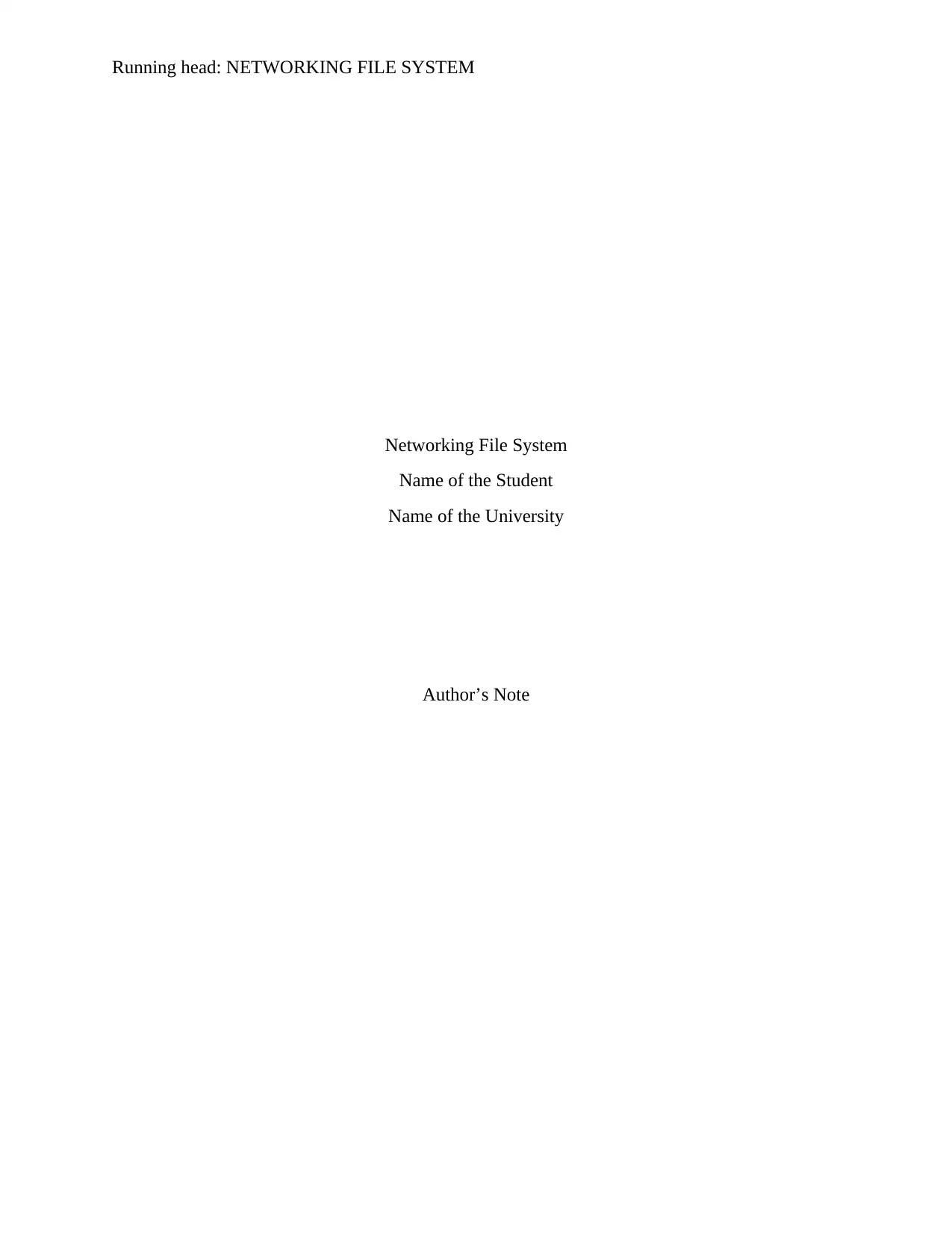
Running head: NETWORKING FILE SYSTEM
Networking File System
Name of the Student
Name of the University
Author’s Note
Networking File System
Name of the Student
Name of the University
Author’s Note
Paraphrase This Document
Need a fresh take? Get an instant paraphrase of this document with our AI Paraphraser
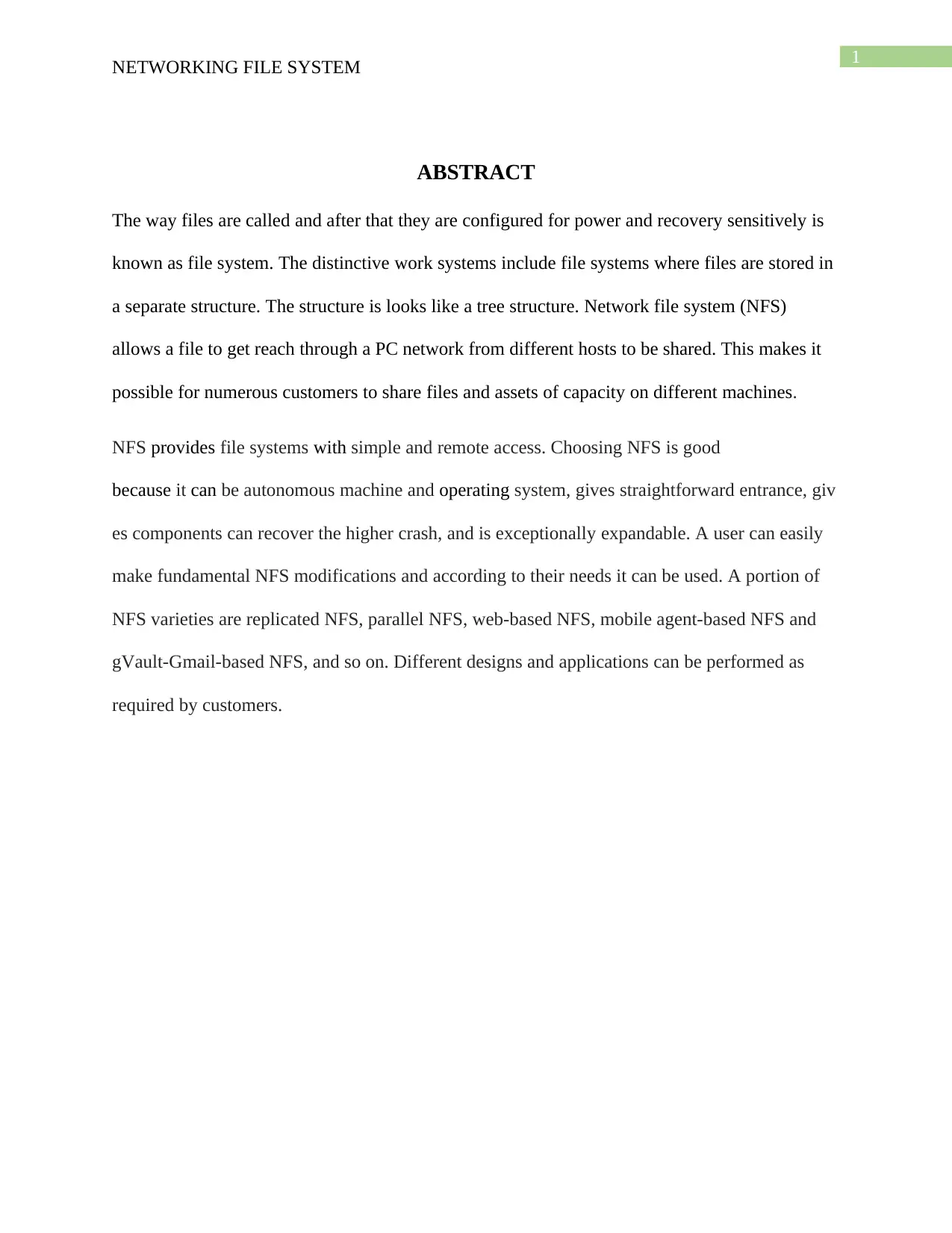
1
NETWORKING FILE SYSTEM
ABSTRACT
The way files are called and after that they are configured for power and recovery sensitively is
known as file system. The distinctive work systems include file systems where files are stored in
a separate structure. The structure is looks like a tree structure. Network file system (NFS)
allows a file to get reach through a PC network from different hosts to be shared. This makes it
possible for numerous customers to share files and assets of capacity on different machines.
NFS provides file systems with simple and remote access. Choosing NFS is good
because it can be autonomous machine and operating system, gives straightforward entrance, giv
es components can recover the higher crash, and is exceptionally expandable. A user can easily
make fundamental NFS modifications and according to their needs it can be used. A portion of
NFS varieties are replicated NFS, parallel NFS, web-based NFS, mobile agent-based NFS and
gVault-Gmail-based NFS, and so on. Different designs and applications can be performed as
required by customers.
NETWORKING FILE SYSTEM
ABSTRACT
The way files are called and after that they are configured for power and recovery sensitively is
known as file system. The distinctive work systems include file systems where files are stored in
a separate structure. The structure is looks like a tree structure. Network file system (NFS)
allows a file to get reach through a PC network from different hosts to be shared. This makes it
possible for numerous customers to share files and assets of capacity on different machines.
NFS provides file systems with simple and remote access. Choosing NFS is good
because it can be autonomous machine and operating system, gives straightforward entrance, giv
es components can recover the higher crash, and is exceptionally expandable. A user can easily
make fundamental NFS modifications and according to their needs it can be used. A portion of
NFS varieties are replicated NFS, parallel NFS, web-based NFS, mobile agent-based NFS and
gVault-Gmail-based NFS, and so on. Different designs and applications can be performed as
required by customers.
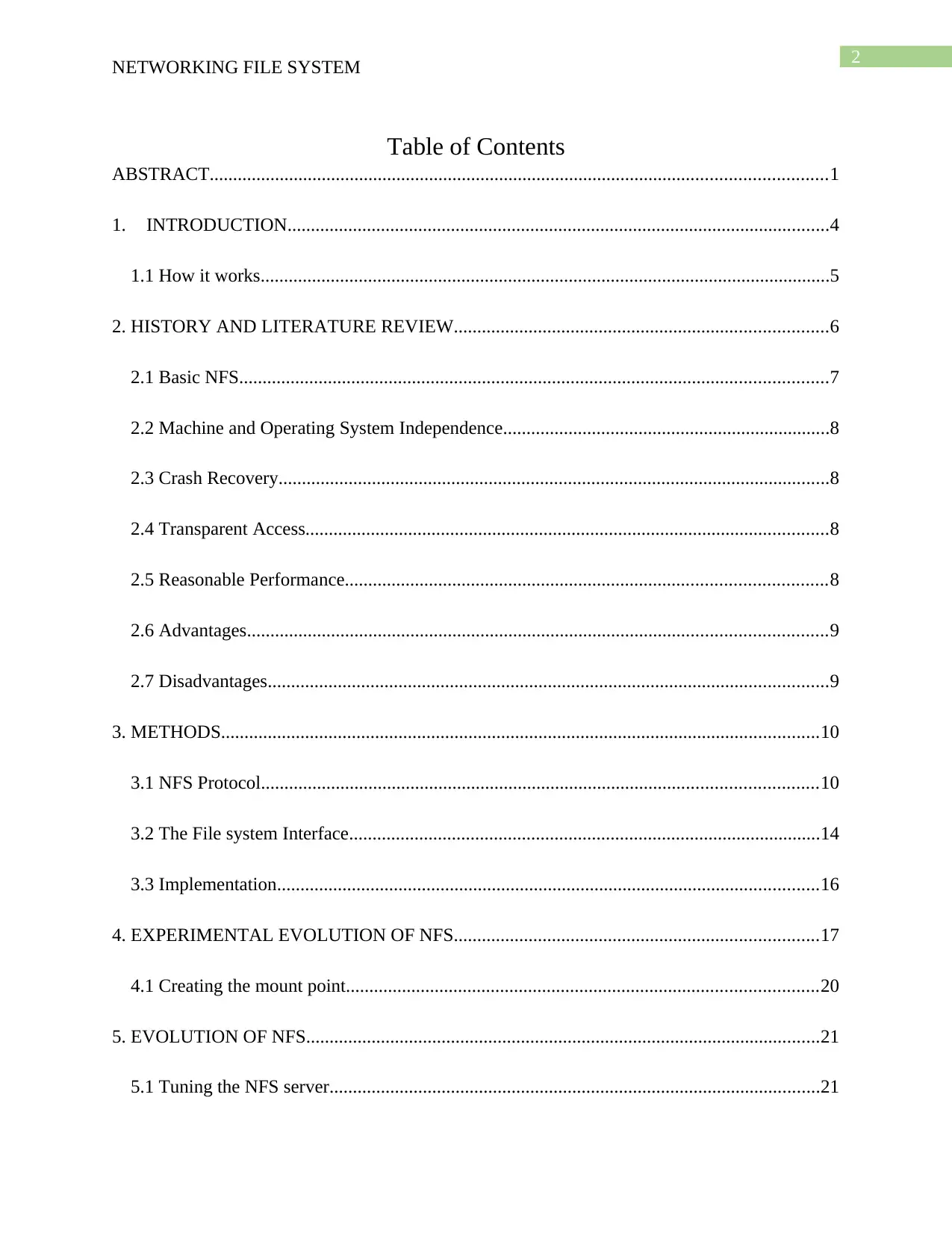
2
NETWORKING FILE SYSTEM
Table of Contents
ABSTRACT....................................................................................................................................1
1. INTRODUCTION....................................................................................................................4
1.1 How it works..........................................................................................................................5
2. HISTORY AND LITERATURE REVIEW................................................................................6
2.1 Basic NFS..............................................................................................................................7
2.2 Machine and Operating System Independence......................................................................8
2.3 Crash Recovery......................................................................................................................8
2.4 Transparent Access................................................................................................................8
2.5 Reasonable Performance.......................................................................................................8
2.6 Advantages............................................................................................................................9
2.7 Disadvantages........................................................................................................................9
3. METHODS................................................................................................................................10
3.1 NFS Protocol.......................................................................................................................10
3.2 The File system Interface.....................................................................................................14
3.3 Implementation....................................................................................................................16
4. EXPERIMENTAL EVOLUTION OF NFS..............................................................................17
4.1 Creating the mount point.....................................................................................................20
5. EVOLUTION OF NFS..............................................................................................................21
5.1 Tuning the NFS server.........................................................................................................21
NETWORKING FILE SYSTEM
Table of Contents
ABSTRACT....................................................................................................................................1
1. INTRODUCTION....................................................................................................................4
1.1 How it works..........................................................................................................................5
2. HISTORY AND LITERATURE REVIEW................................................................................6
2.1 Basic NFS..............................................................................................................................7
2.2 Machine and Operating System Independence......................................................................8
2.3 Crash Recovery......................................................................................................................8
2.4 Transparent Access................................................................................................................8
2.5 Reasonable Performance.......................................................................................................8
2.6 Advantages............................................................................................................................9
2.7 Disadvantages........................................................................................................................9
3. METHODS................................................................................................................................10
3.1 NFS Protocol.......................................................................................................................10
3.2 The File system Interface.....................................................................................................14
3.3 Implementation....................................................................................................................16
4. EXPERIMENTAL EVOLUTION OF NFS..............................................................................17
4.1 Creating the mount point.....................................................................................................20
5. EVOLUTION OF NFS..............................................................................................................21
5.1 Tuning the NFS server.........................................................................................................21
⊘ This is a preview!⊘
Do you want full access?
Subscribe today to unlock all pages.

Trusted by 1+ million students worldwide

3
NETWORKING FILE SYSTEM
5.2 Resolving Performance Problems........................................................................................21
6. CONCLUSION......................................................................................................................22
References......................................................................................................................................23
NETWORKING FILE SYSTEM
5.2 Resolving Performance Problems........................................................................................21
6. CONCLUSION......................................................................................................................22
References......................................................................................................................................23
Paraphrase This Document
Need a fresh take? Get an instant paraphrase of this document with our AI Paraphraser
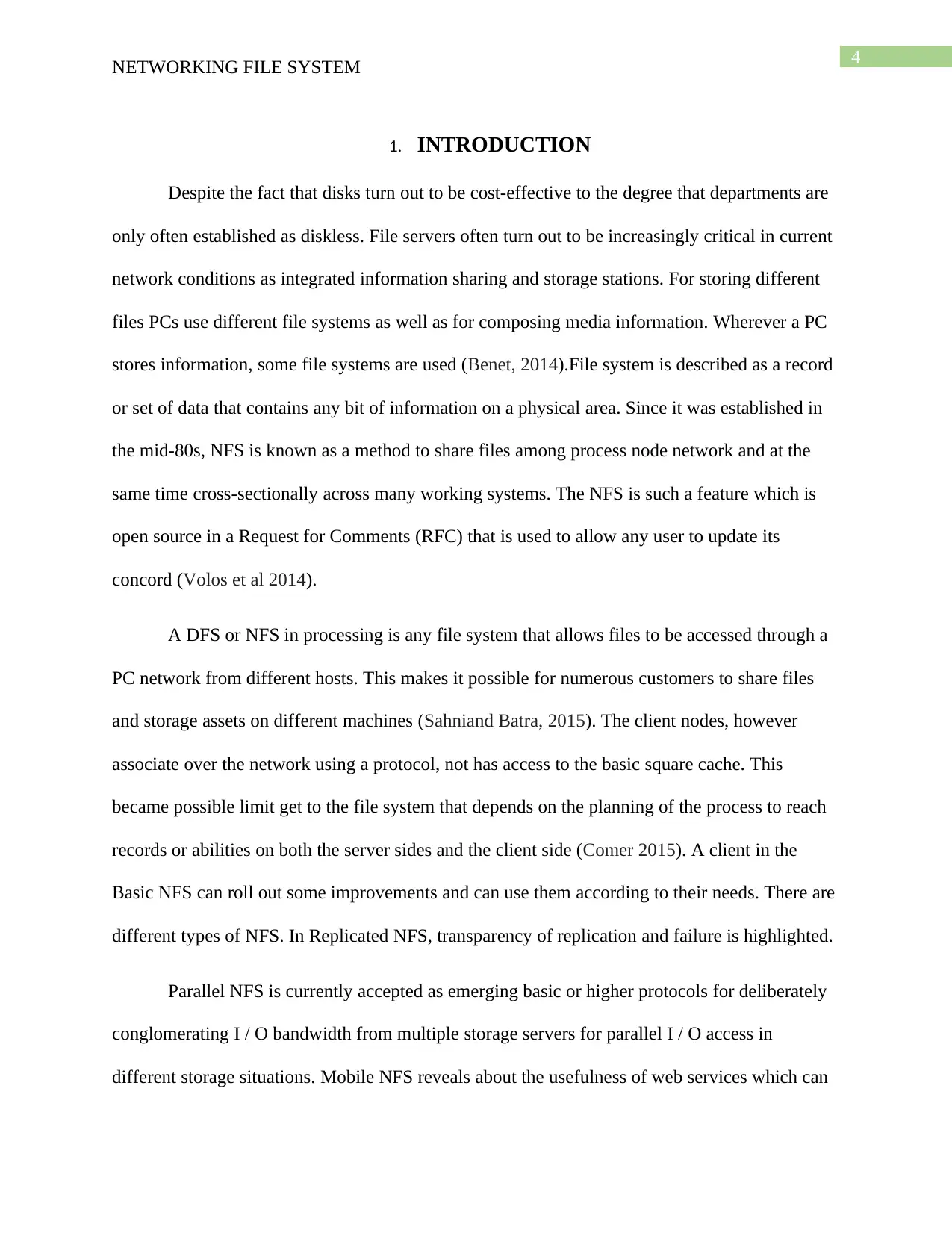
4
NETWORKING FILE SYSTEM
1. INTRODUCTION
Despite the fact that disks turn out to be cost-effective to the degree that departments are
only often established as diskless. File servers often turn out to be increasingly critical in current
network conditions as integrated information sharing and storage stations. For storing different
files PCs use different file systems as well as for composing media information. Wherever a PC
stores information, some file systems are used (Benet, 2014).File system is described as a record
or set of data that contains any bit of information on a physical area. Since it was established in
the mid-80s, NFS is known as a method to share files among process node network and at the
same time cross-sectionally across many working systems. The NFS is such a feature which is
open source in a Request for Comments (RFC) that is used to allow any user to update its
concord (Volos et al 2014).
A DFS or NFS in processing is any file system that allows files to be accessed through a
PC network from different hosts. This makes it possible for numerous customers to share files
and storage assets on different machines (Sahniand Batra, 2015). The client nodes, however
associate over the network using a protocol, not has access to the basic square cache. This
became possible limit get to the file system that depends on the planning of the process to reach
records or abilities on both the server sides and the client side (Comer 2015). A client in the
Basic NFS can roll out some improvements and can use them according to their needs. There are
different types of NFS. In Replicated NFS, transparency of replication and failure is highlighted.
Parallel NFS is currently accepted as emerging basic or higher protocols for deliberately
conglomerating I / O bandwidth from multiple storage servers for parallel I / O access in
different storage situations. Mobile NFS reveals about the usefulness of web services which can
NETWORKING FILE SYSTEM
1. INTRODUCTION
Despite the fact that disks turn out to be cost-effective to the degree that departments are
only often established as diskless. File servers often turn out to be increasingly critical in current
network conditions as integrated information sharing and storage stations. For storing different
files PCs use different file systems as well as for composing media information. Wherever a PC
stores information, some file systems are used (Benet, 2014).File system is described as a record
or set of data that contains any bit of information on a physical area. Since it was established in
the mid-80s, NFS is known as a method to share files among process node network and at the
same time cross-sectionally across many working systems. The NFS is such a feature which is
open source in a Request for Comments (RFC) that is used to allow any user to update its
concord (Volos et al 2014).
A DFS or NFS in processing is any file system that allows files to be accessed through a
PC network from different hosts. This makes it possible for numerous customers to share files
and storage assets on different machines (Sahniand Batra, 2015). The client nodes, however
associate over the network using a protocol, not has access to the basic square cache. This
became possible limit get to the file system that depends on the planning of the process to reach
records or abilities on both the server sides and the client side (Comer 2015). A client in the
Basic NFS can roll out some improvements and can use them according to their needs. There are
different types of NFS. In Replicated NFS, transparency of replication and failure is highlighted.
Parallel NFS is currently accepted as emerging basic or higher protocols for deliberately
conglomerating I / O bandwidth from multiple storage servers for parallel I / O access in
different storage situations. Mobile NFS reveals about the usefulness of web services which can
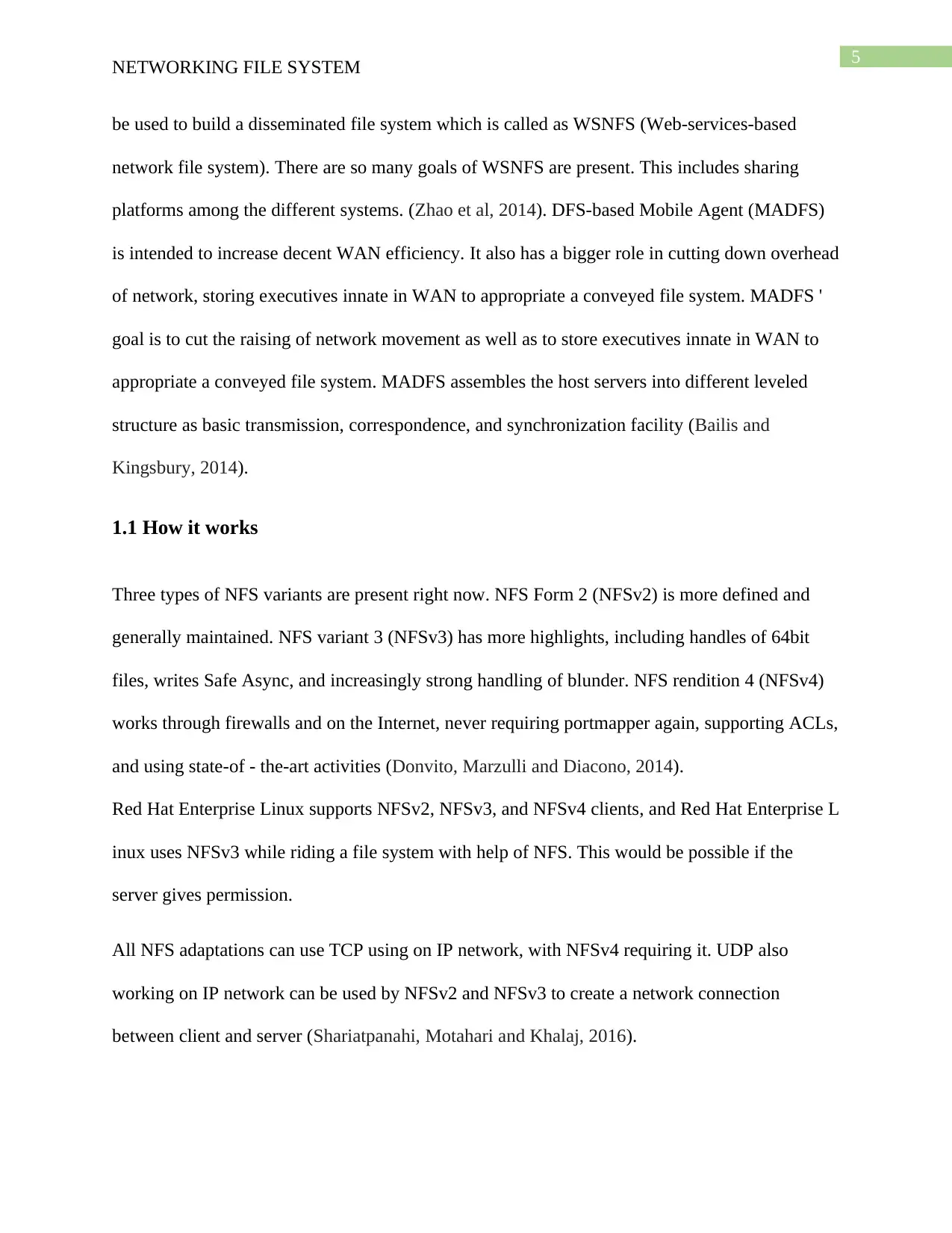
5
NETWORKING FILE SYSTEM
be used to build a disseminated file system which is called as WSNFS (Web-services-based
network file system). There are so many goals of WSNFS are present. This includes sharing
platforms among the different systems. (Zhao et al, 2014). DFS-based Mobile Agent (MADFS)
is intended to increase decent WAN efficiency. It also has a bigger role in cutting down overhead
of network, storing executives innate in WAN to appropriate a conveyed file system. MADFS '
goal is to cut the raising of network movement as well as to store executives innate in WAN to
appropriate a conveyed file system. MADFS assembles the host servers into different leveled
structure as basic transmission, correspondence, and synchronization facility (Bailis and
Kingsbury, 2014).
1.1 How it works
Three types of NFS variants are present right now. NFS Form 2 (NFSv2) is more defined and
generally maintained. NFS variant 3 (NFSv3) has more highlights, including handles of 64bit
files, writes Safe Async, and increasingly strong handling of blunder. NFS rendition 4 (NFSv4)
works through firewalls and on the Internet, never requiring portmapper again, supporting ACLs,
and using state-of - the-art activities (Donvito, Marzulli and Diacono, 2014).
Red Hat Enterprise Linux supports NFSv2, NFSv3, and NFSv4 clients, and Red Hat Enterprise L
inux uses NFSv3 while riding a file system with help of NFS. This would be possible if the
server gives permission.
All NFS adaptations can use TCP using on IP network, with NFSv4 requiring it. UDP also
working on IP network can be used by NFSv2 and NFSv3 to create a network connection
between client and server (Shariatpanahi, Motahari and Khalaj, 2016).
NETWORKING FILE SYSTEM
be used to build a disseminated file system which is called as WSNFS (Web-services-based
network file system). There are so many goals of WSNFS are present. This includes sharing
platforms among the different systems. (Zhao et al, 2014). DFS-based Mobile Agent (MADFS)
is intended to increase decent WAN efficiency. It also has a bigger role in cutting down overhead
of network, storing executives innate in WAN to appropriate a conveyed file system. MADFS '
goal is to cut the raising of network movement as well as to store executives innate in WAN to
appropriate a conveyed file system. MADFS assembles the host servers into different leveled
structure as basic transmission, correspondence, and synchronization facility (Bailis and
Kingsbury, 2014).
1.1 How it works
Three types of NFS variants are present right now. NFS Form 2 (NFSv2) is more defined and
generally maintained. NFS variant 3 (NFSv3) has more highlights, including handles of 64bit
files, writes Safe Async, and increasingly strong handling of blunder. NFS rendition 4 (NFSv4)
works through firewalls and on the Internet, never requiring portmapper again, supporting ACLs,
and using state-of - the-art activities (Donvito, Marzulli and Diacono, 2014).
Red Hat Enterprise Linux supports NFSv2, NFSv3, and NFSv4 clients, and Red Hat Enterprise L
inux uses NFSv3 while riding a file system with help of NFS. This would be possible if the
server gives permission.
All NFS adaptations can use TCP using on IP network, with NFSv4 requiring it. UDP also
working on IP network can be used by NFSv2 and NFSv3 to create a network connection
between client and server (Shariatpanahi, Motahari and Khalaj, 2016).
⊘ This is a preview!⊘
Do you want full access?
Subscribe today to unlock all pages.

Trusted by 1+ million students worldwide
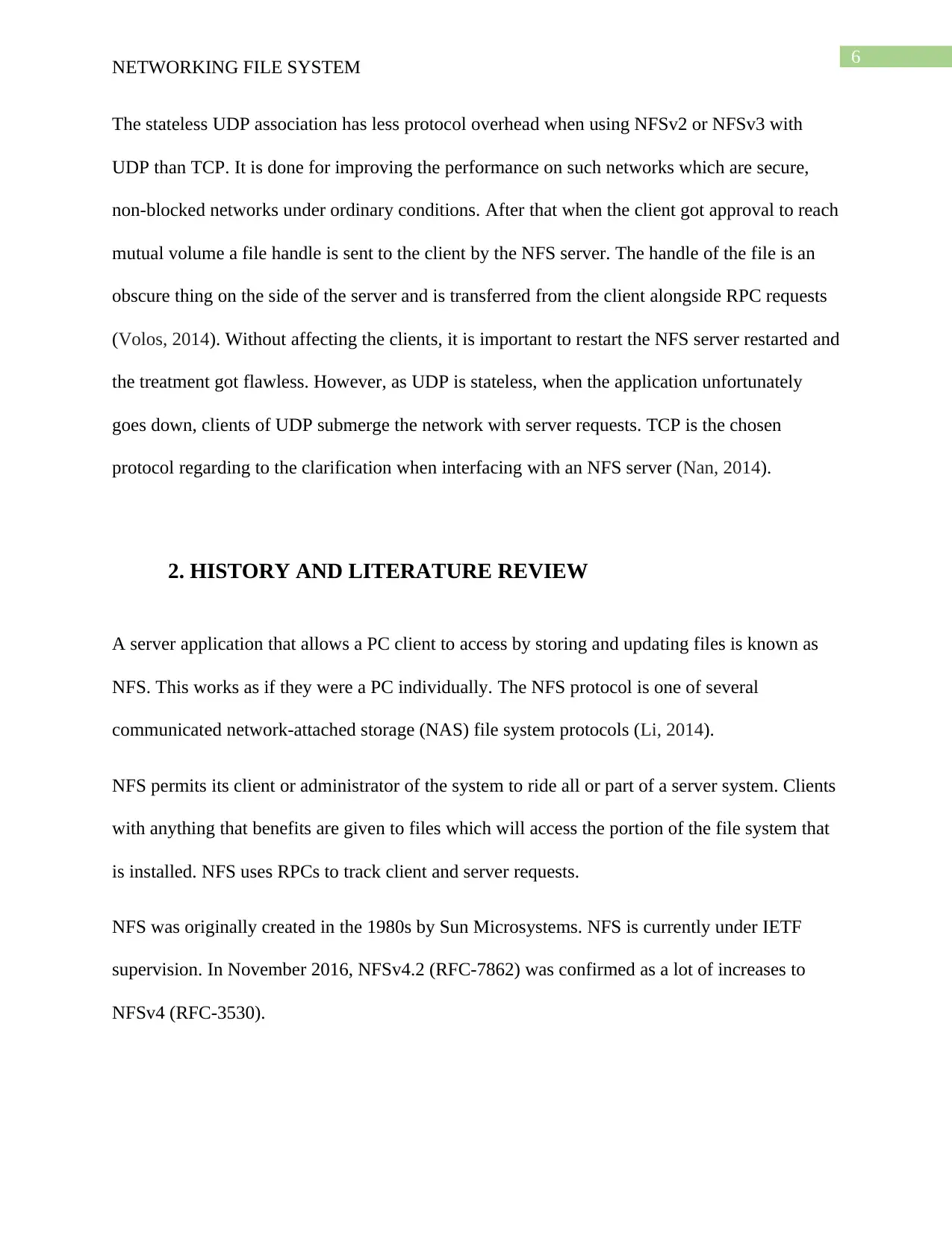
6
NETWORKING FILE SYSTEM
The stateless UDP association has less protocol overhead when using NFSv2 or NFSv3 with
UDP than TCP. It is done for improving the performance on such networks which are secure,
non-blocked networks under ordinary conditions. After that when the client got approval to reach
mutual volume a file handle is sent to the client by the NFS server. The handle of the file is an
obscure thing on the side of the server and is transferred from the client alongside RPC requests
(Volos, 2014). Without affecting the clients, it is important to restart the NFS server restarted and
the treatment got flawless. However, as UDP is stateless, when the application unfortunately
goes down, clients of UDP submerge the network with server requests. TCP is the chosen
protocol regarding to the clarification when interfacing with an NFS server (Nan, 2014).
2. HISTORY AND LITERATURE REVIEW
A server application that allows a PC client to access by storing and updating files is known as
NFS. This works as if they were a PC individually. The NFS protocol is one of several
communicated network-attached storage (NAS) file system protocols (Li, 2014).
NFS permits its client or administrator of the system to ride all or part of a server system. Clients
with anything that benefits are given to files which will access the portion of the file system that
is installed. NFS uses RPCs to track client and server requests.
NFS was originally created in the 1980s by Sun Microsystems. NFS is currently under IETF
supervision. In November 2016, NFSv4.2 (RFC-7862) was confirmed as a lot of increases to
NFSv4 (RFC-3530).
NETWORKING FILE SYSTEM
The stateless UDP association has less protocol overhead when using NFSv2 or NFSv3 with
UDP than TCP. It is done for improving the performance on such networks which are secure,
non-blocked networks under ordinary conditions. After that when the client got approval to reach
mutual volume a file handle is sent to the client by the NFS server. The handle of the file is an
obscure thing on the side of the server and is transferred from the client alongside RPC requests
(Volos, 2014). Without affecting the clients, it is important to restart the NFS server restarted and
the treatment got flawless. However, as UDP is stateless, when the application unfortunately
goes down, clients of UDP submerge the network with server requests. TCP is the chosen
protocol regarding to the clarification when interfacing with an NFS server (Nan, 2014).
2. HISTORY AND LITERATURE REVIEW
A server application that allows a PC client to access by storing and updating files is known as
NFS. This works as if they were a PC individually. The NFS protocol is one of several
communicated network-attached storage (NAS) file system protocols (Li, 2014).
NFS permits its client or administrator of the system to ride all or part of a server system. Clients
with anything that benefits are given to files which will access the portion of the file system that
is installed. NFS uses RPCs to track client and server requests.
NFS was originally created in the 1980s by Sun Microsystems. NFS is currently under IETF
supervision. In November 2016, NFSv4.2 (RFC-7862) was confirmed as a lot of increases to
NFSv4 (RFC-3530).
Paraphrase This Document
Need a fresh take? Get an instant paraphrase of this document with our AI Paraphraser
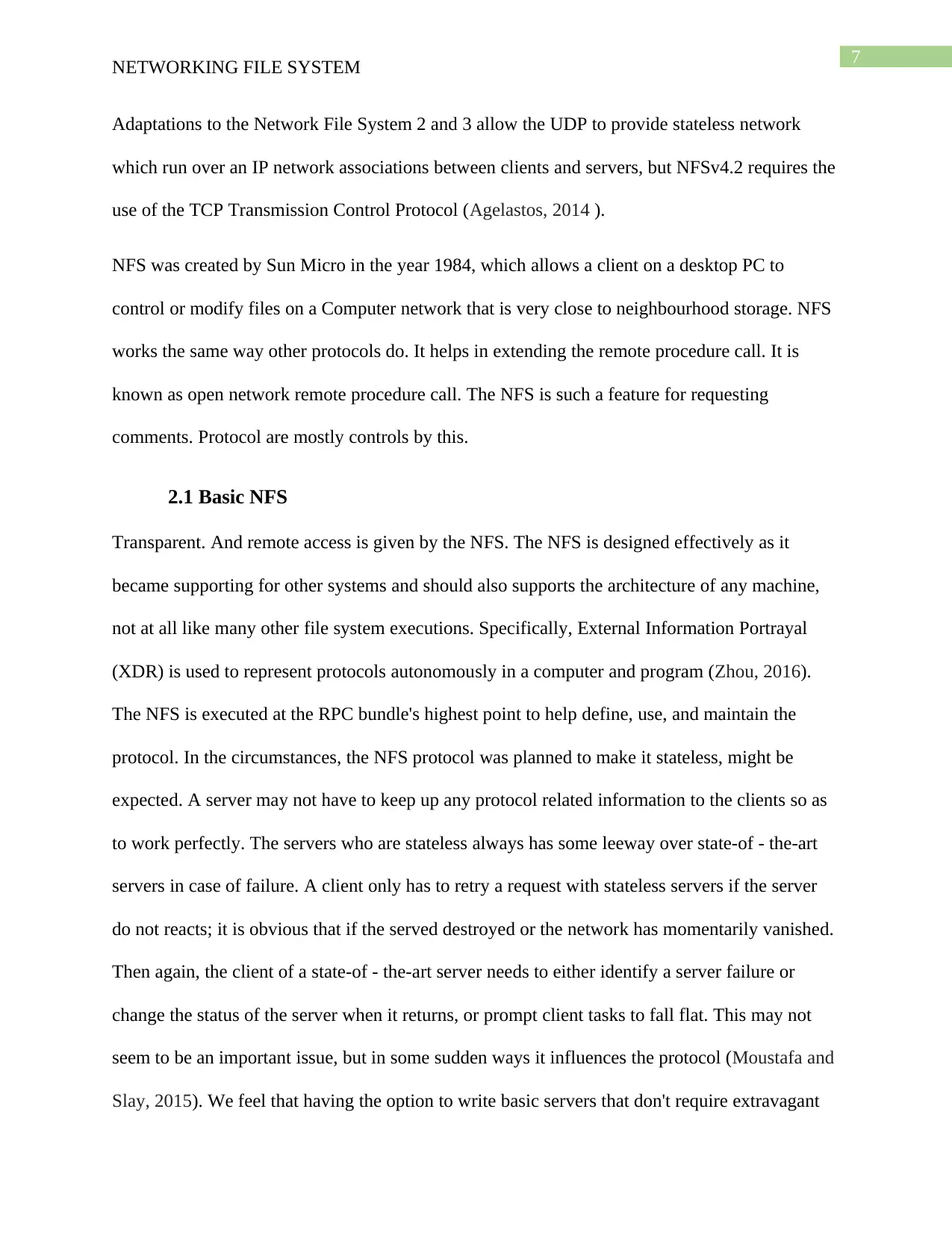
7
NETWORKING FILE SYSTEM
Adaptations to the Network File System 2 and 3 allow the UDP to provide stateless network
which run over an IP network associations between clients and servers, but NFSv4.2 requires the
use of the TCP Transmission Control Protocol (Agelastos, 2014 ).
NFS was created by Sun Micro in the year 1984, which allows a client on a desktop PC to
control or modify files on a Computer network that is very close to neighbourhood storage. NFS
works the same way other protocols do. It helps in extending the remote procedure call. It is
known as open network remote procedure call. The NFS is such a feature for requesting
comments. Protocol are mostly controls by this.
2.1 Basic NFS
Transparent. And remote access is given by the NFS. The NFS is designed effectively as it
became supporting for other systems and should also supports the architecture of any machine,
not at all like many other file system executions. Specifically, External Information Portrayal
(XDR) is used to represent protocols autonomously in a computer and program (Zhou, 2016).
The NFS is executed at the RPC bundle's highest point to help define, use, and maintain the
protocol. In the circumstances, the NFS protocol was planned to make it stateless, might be
expected. A server may not have to keep up any protocol related information to the clients so as
to work perfectly. The servers who are stateless always has some leeway over state-of - the-art
servers in case of failure. A client only has to retry a request with stateless servers if the server
do not reacts; it is obvious that if the served destroyed or the network has momentarily vanished.
Then again, the client of a state-of - the-art server needs to either identify a server failure or
change the status of the server when it returns, or prompt client tasks to fall flat. This may not
seem to be an important issue, but in some sudden ways it influences the protocol (Moustafa and
Slay, 2015). We feel that having the option to write basic servers that don't require extravagant
NETWORKING FILE SYSTEM
Adaptations to the Network File System 2 and 3 allow the UDP to provide stateless network
which run over an IP network associations between clients and servers, but NFSv4.2 requires the
use of the TCP Transmission Control Protocol (Agelastos, 2014 ).
NFS was created by Sun Micro in the year 1984, which allows a client on a desktop PC to
control or modify files on a Computer network that is very close to neighbourhood storage. NFS
works the same way other protocols do. It helps in extending the remote procedure call. It is
known as open network remote procedure call. The NFS is such a feature for requesting
comments. Protocol are mostly controls by this.
2.1 Basic NFS
Transparent. And remote access is given by the NFS. The NFS is designed effectively as it
became supporting for other systems and should also supports the architecture of any machine,
not at all like many other file system executions. Specifically, External Information Portrayal
(XDR) is used to represent protocols autonomously in a computer and program (Zhou, 2016).
The NFS is executed at the RPC bundle's highest point to help define, use, and maintain the
protocol. In the circumstances, the NFS protocol was planned to make it stateless, might be
expected. A server may not have to keep up any protocol related information to the clients so as
to work perfectly. The servers who are stateless always has some leeway over state-of - the-art
servers in case of failure. A client only has to retry a request with stateless servers if the server
do not reacts; it is obvious that if the served destroyed or the network has momentarily vanished.
Then again, the client of a state-of - the-art server needs to either identify a server failure or
change the status of the server when it returns, or prompt client tasks to fall flat. This may not
seem to be an important issue, but in some sudden ways it influences the protocol (Moustafa and
Slay, 2015). We feel that having the option to write basic servers that don't require extravagant

8
NETWORKING FILE SYSTEM
crash recovery might cause complexities. Note that regardless of whether, for example, "solid"
transport protocol is used, as customer should have the option of reopening service interferences.
Such objectives of BFS were:
NETWORKING FILE SYSTEM
crash recovery might cause complexities. Note that regardless of whether, for example, "solid"
transport protocol is used, as customer should have the option of reopening service interferences.
Such objectives of BFS were:
⊘ This is a preview!⊘
Do you want full access?
Subscribe today to unlock all pages.

Trusted by 1+ million students worldwide
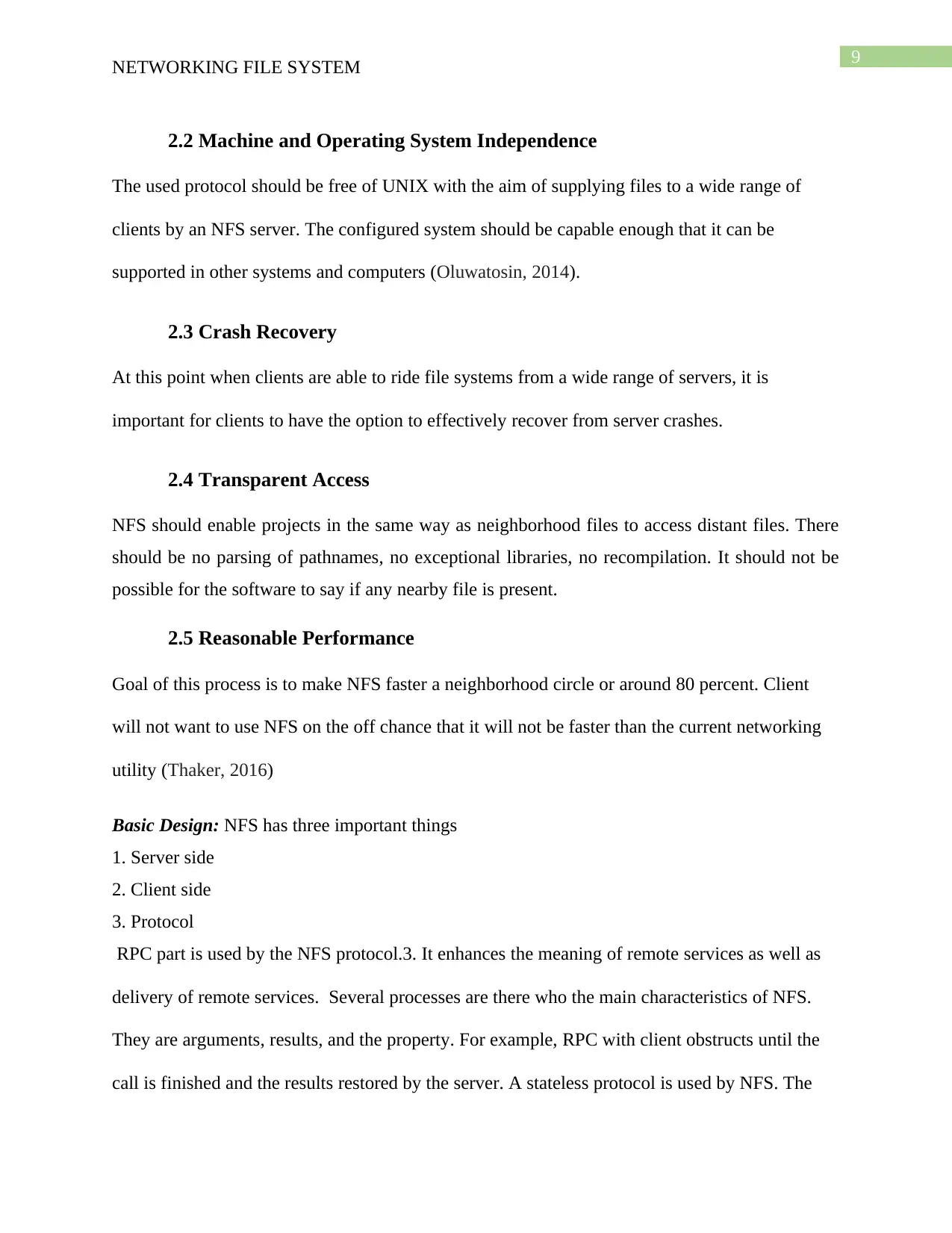
9
NETWORKING FILE SYSTEM
2.2 Machine and Operating System Independence
The used protocol should be free of UNIX with the aim of supplying files to a wide range of
clients by an NFS server. The configured system should be capable enough that it can be
supported in other systems and computers (Oluwatosin, 2014).
2.3 Crash Recovery
At this point when clients are able to ride file systems from a wide range of servers, it is
important for clients to have the option to effectively recover from server crashes.
2.4 Transparent Access
NFS should enable projects in the same way as neighborhood files to access distant files. There
should be no parsing of pathnames, no exceptional libraries, no recompilation. It should not be
possible for the software to say if any nearby file is present.
2.5 Reasonable Performance
Goal of this process is to make NFS faster a neighborhood circle or around 80 percent. Client
will not want to use NFS on the off chance that it will not be faster than the current networking
utility (Thaker, 2016)
Basic Design: NFS has three important things
1. Server side
2. Client side
3. Protocol
RPC part is used by the NFS protocol.3. It enhances the meaning of remote services as well as
delivery of remote services. Several processes are there who the main characteristics of NFS.
They are arguments, results, and the property. For example, RPC with client obstructs until the
call is finished and the results restored by the server. A stateless protocol is used by NFS. The
NETWORKING FILE SYSTEM
2.2 Machine and Operating System Independence
The used protocol should be free of UNIX with the aim of supplying files to a wide range of
clients by an NFS server. The configured system should be capable enough that it can be
supported in other systems and computers (Oluwatosin, 2014).
2.3 Crash Recovery
At this point when clients are able to ride file systems from a wide range of servers, it is
important for clients to have the option to effectively recover from server crashes.
2.4 Transparent Access
NFS should enable projects in the same way as neighborhood files to access distant files. There
should be no parsing of pathnames, no exceptional libraries, no recompilation. It should not be
possible for the software to say if any nearby file is present.
2.5 Reasonable Performance
Goal of this process is to make NFS faster a neighborhood circle or around 80 percent. Client
will not want to use NFS on the off chance that it will not be faster than the current networking
utility (Thaker, 2016)
Basic Design: NFS has three important things
1. Server side
2. Client side
3. Protocol
RPC part is used by the NFS protocol.3. It enhances the meaning of remote services as well as
delivery of remote services. Several processes are there who the main characteristics of NFS.
They are arguments, results, and the property. For example, RPC with client obstructs until the
call is finished and the results restored by the server. A stateless protocol is used by NFS. The
Paraphrase This Document
Need a fresh take? Get an instant paraphrase of this document with our AI Paraphraser
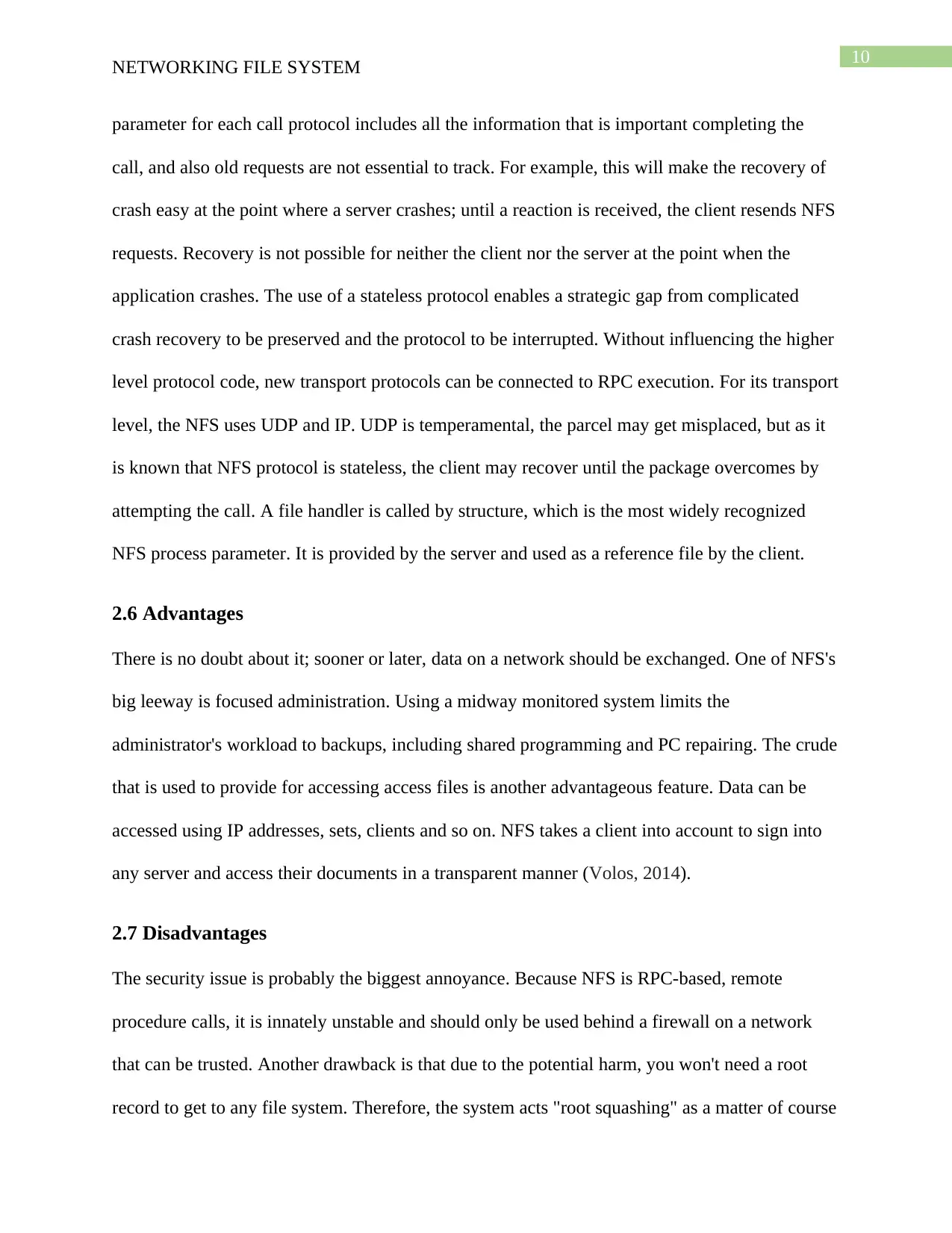
10
NETWORKING FILE SYSTEM
parameter for each call protocol includes all the information that is important completing the
call, and also old requests are not essential to track. For example, this will make the recovery of
crash easy at the point where a server crashes; until a reaction is received, the client resends NFS
requests. Recovery is not possible for neither the client nor the server at the point when the
application crashes. The use of a stateless protocol enables a strategic gap from complicated
crash recovery to be preserved and the protocol to be interrupted. Without influencing the higher
level protocol code, new transport protocols can be connected to RPC execution. For its transport
level, the NFS uses UDP and IP. UDP is temperamental, the parcel may get misplaced, but as it
is known that NFS protocol is stateless, the client may recover until the package overcomes by
attempting the call. A file handler is called by structure, which is the most widely recognized
NFS process parameter. It is provided by the server and used as a reference file by the client.
2.6 Advantages
There is no doubt about it; sooner or later, data on a network should be exchanged. One of NFS's
big leeway is focused administration. Using a midway monitored system limits the
administrator's workload to backups, including shared programming and PC repairing. The crude
that is used to provide for accessing access files is another advantageous feature. Data can be
accessed using IP addresses, sets, clients and so on. NFS takes a client into account to sign into
any server and access their documents in a transparent manner (Volos, 2014).
2.7 Disadvantages
The security issue is probably the biggest annoyance. Because NFS is RPC-based, remote
procedure calls, it is innately unstable and should only be used behind a firewall on a network
that can be trusted. Another drawback is that due to the potential harm, you won't need a root
record to get to any file system. Therefore, the system acts "root squashing" as a matter of course
NETWORKING FILE SYSTEM
parameter for each call protocol includes all the information that is important completing the
call, and also old requests are not essential to track. For example, this will make the recovery of
crash easy at the point where a server crashes; until a reaction is received, the client resends NFS
requests. Recovery is not possible for neither the client nor the server at the point when the
application crashes. The use of a stateless protocol enables a strategic gap from complicated
crash recovery to be preserved and the protocol to be interrupted. Without influencing the higher
level protocol code, new transport protocols can be connected to RPC execution. For its transport
level, the NFS uses UDP and IP. UDP is temperamental, the parcel may get misplaced, but as it
is known that NFS protocol is stateless, the client may recover until the package overcomes by
attempting the call. A file handler is called by structure, which is the most widely recognized
NFS process parameter. It is provided by the server and used as a reference file by the client.
2.6 Advantages
There is no doubt about it; sooner or later, data on a network should be exchanged. One of NFS's
big leeway is focused administration. Using a midway monitored system limits the
administrator's workload to backups, including shared programming and PC repairing. The crude
that is used to provide for accessing access files is another advantageous feature. Data can be
accessed using IP addresses, sets, clients and so on. NFS takes a client into account to sign into
any server and access their documents in a transparent manner (Volos, 2014).
2.7 Disadvantages
The security issue is probably the biggest annoyance. Because NFS is RPC-based, remote
procedure calls, it is innately unstable and should only be used behind a firewall on a network
that can be trusted. Another drawback is that due to the potential harm, you won't need a root
record to get to any file system. Therefore, the system acts "root squashing" as a matter of course
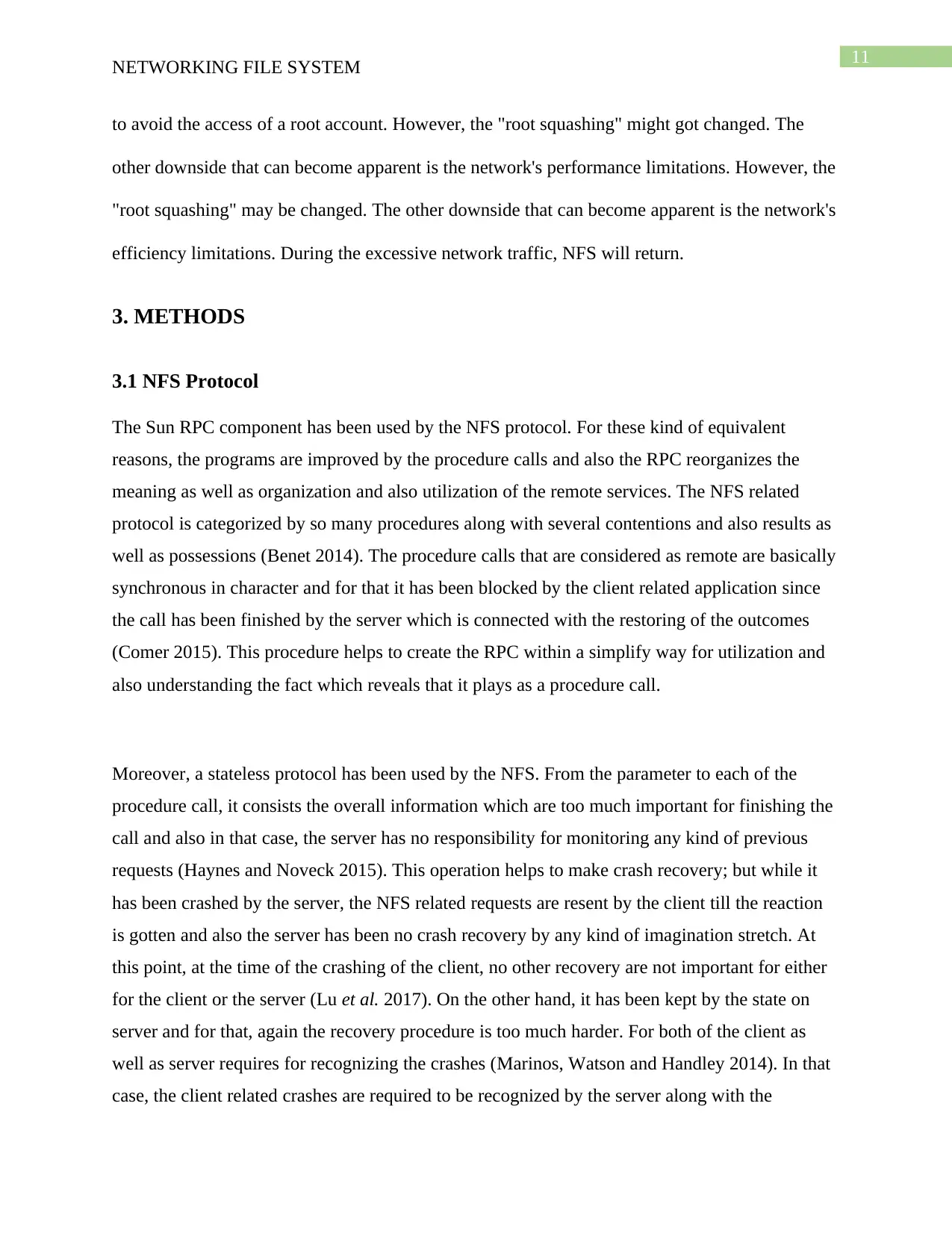
11
NETWORKING FILE SYSTEM
to avoid the access of a root account. However, the "root squashing" might got changed. The
other downside that can become apparent is the network's performance limitations. However, the
"root squashing" may be changed. The other downside that can become apparent is the network's
efficiency limitations. During the excessive network traffic, NFS will return.
3. METHODS
3.1 NFS Protocol
The Sun RPC component has been used by the NFS protocol. For these kind of equivalent
reasons, the programs are improved by the procedure calls and also the RPC reorganizes the
meaning as well as organization and also utilization of the remote services. The NFS related
protocol is categorized by so many procedures along with several contentions and also results as
well as possessions (Benet 2014). The procedure calls that are considered as remote are basically
synchronous in character and for that it has been blocked by the client related application since
the call has been finished by the server which is connected with the restoring of the outcomes
(Comer 2015). This procedure helps to create the RPC within a simplify way for utilization and
also understanding the fact which reveals that it plays as a procedure call.
Moreover, a stateless protocol has been used by the NFS. From the parameter to each of the
procedure call, it consists the overall information which are too much important for finishing the
call and also in that case, the server has no responsibility for monitoring any kind of previous
requests (Haynes and Noveck 2015). This operation helps to make crash recovery; but while it
has been crashed by the server, the NFS related requests are resent by the client till the reaction
is gotten and also the server has been no crash recovery by any kind of imagination stretch. At
this point, at the time of the crashing of the client, no other recovery are not important for either
for the client or the server (Lu et al. 2017). On the other hand, it has been kept by the state on
server and for that, again the recovery procedure is too much harder. For both of the client as
well as server requires for recognizing the crashes (Marinos, Watson and Handley 2014). In that
case, the client related crashes are required to be recognized by the server along with the
NETWORKING FILE SYSTEM
to avoid the access of a root account. However, the "root squashing" might got changed. The
other downside that can become apparent is the network's performance limitations. However, the
"root squashing" may be changed. The other downside that can become apparent is the network's
efficiency limitations. During the excessive network traffic, NFS will return.
3. METHODS
3.1 NFS Protocol
The Sun RPC component has been used by the NFS protocol. For these kind of equivalent
reasons, the programs are improved by the procedure calls and also the RPC reorganizes the
meaning as well as organization and also utilization of the remote services. The NFS related
protocol is categorized by so many procedures along with several contentions and also results as
well as possessions (Benet 2014). The procedure calls that are considered as remote are basically
synchronous in character and for that it has been blocked by the client related application since
the call has been finished by the server which is connected with the restoring of the outcomes
(Comer 2015). This procedure helps to create the RPC within a simplify way for utilization and
also understanding the fact which reveals that it plays as a procedure call.
Moreover, a stateless protocol has been used by the NFS. From the parameter to each of the
procedure call, it consists the overall information which are too much important for finishing the
call and also in that case, the server has no responsibility for monitoring any kind of previous
requests (Haynes and Noveck 2015). This operation helps to make crash recovery; but while it
has been crashed by the server, the NFS related requests are resent by the client till the reaction
is gotten and also the server has been no crash recovery by any kind of imagination stretch. At
this point, at the time of the crashing of the client, no other recovery are not important for either
for the client or the server (Lu et al. 2017). On the other hand, it has been kept by the state on
server and for that, again the recovery procedure is too much harder. For both of the client as
well as server requires for recognizing the crashes (Marinos, Watson and Handley 2014). In that
case, the client related crashes are required to be recognized by the server along with the
⊘ This is a preview!⊘
Do you want full access?
Subscribe today to unlock all pages.

Trusted by 1+ million students worldwide
1 out of 30
Related Documents
Your All-in-One AI-Powered Toolkit for Academic Success.
+13062052269
info@desklib.com
Available 24*7 on WhatsApp / Email
![[object Object]](/_next/static/media/star-bottom.7253800d.svg)
Unlock your academic potential
Copyright © 2020–2025 A2Z Services. All Rights Reserved. Developed and managed by ZUCOL.





